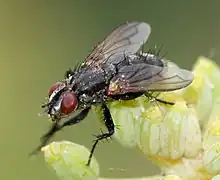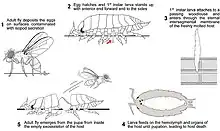| Rhinophorinae | |
|---|---|
 | |
| Stevenia sp. | |
| Scientific classification | |
| Domain: | Eukaryota |
| Kingdom: | Animalia |
| Phylum: | Arthropoda |
| Class: | Insecta |
| Order: | Diptera |
| (unranked): | Cyclorrhapha |
| Section: | Schizophora |
| Subsection: | Calyptratae |
| Superfamily: | Oestroidea |
| Family: | Calliphoridae |
| Subfamily: | Rhinophorinae Robineau-Desvoidy, 1863[1] |
| Tibes | |
| |
| Synonyms | |
|
Axiniidae Colless, 1994[2] | |

Schematic representation of the infection cycle of a Rhinophoridae fly in a woodlouse host.
Rhinophorinae is a subfamily of flies (Diptera), commonly known as Woodlouse Flies,[3] found in all zoogeographic regions except Oceania, but mainly in the Palaearctic and Afrotropical regions.
They are small, slender, black, bristly flies phylogenetically close to the Tachinidae, formally many authors considered them a family, they are now a subfamily in the Calliphoridae.[4] The larvae are mostly parasitoids of woodlice, beetles, spiders, and other arthropods, and occasionally snails.
By 2020, about 33 genera were placed in the family, with a total 177 species.[3]
Genera
- Acompomintho Villeneuve, 1927
- Apomorphyto Cerretti, Lo Giudice & Pape, 2014[5]
- Aporeomyia Pape & Shima, 1993[6]
- Axinia Colless, 1994[2]
- Azaisia Villeneuve, 1939[7]
- Baniassa Kugler, 1978[8]
- Bezzimyia Townsend, 1919
- Bixinia Cerretti, Lo Giudice & Pape, 2014[5]
- Comoromyia Crosskey, 1977[9]
- Kinabalumyia Cerretti & Pape, 2020
- Macrotarsina Schiner, 1857[10]
- Malayia Malloch, 1926
- Marshallicona Cerretti & Pape, 2020
- Maurhinophora Cerretti & Pape, 2020
- Melanomyoides Crosskey, 1977[9]
- Melanophora Meigen, 1803
- Metoplisa Kugler, 1978
- Neotarsina Cerretti & Pape, 2020
- Oplisa Rondani, 1862[11]
- Parazamimus Verbeke, 1962
- Paykullia Robineau-Desvoidy, 1830[12]
- Phyto Robineau-Desvoidy, 1830[12]
- Queximyia Crosskey, 1977[9]
- Rhinodonia Cerretti, Lo Giudice & Pape, 2014[5]
- Rhinomorinia Brauer & von Bergenstamm, 1889[13]
- Rhinopeza Cerretti, Lo Giudice & Pape, 2014[5]
- Rhinophora Robineau-Desvoidy, 1830[12]
- Shannoniella Townsend, 1939[14]
- Stevenia Robineau-Desvoidy, 1830[12]
- Tricogena Rondani, 1856[15]
- Tromodesia Rondani, 1856[15]
- Trypetidomima Townsend, 1919
- Ventrops Crosskey, 1977[9]
References
- ↑ Robineau-Desvoidy, J.B. (1863). Histoire naturelle des diptères des environs de Paris. Tome premiere. Paris: Masson et Fils. pp. xii + 1143.
- 1 2 Colless DH (1994). "A new family of muscoid Diptera from Australasia, with sixteen new species in four new genera (Diptera: Axiniidae)". Invertebrate Taxonomy. 10 (2): 471–534. doi:10.1071/IT9940471.
- 1 2 Cerretti, Pierfilippo; Badano, Davide; Gisondi, Silvia; Lo Giudice, Giuseppe; Pape, Thomas (15 Jan 2020). "The world woodlouse flies (Diptera, Rhinophoridae)". ZooKeys (903): 1–130. doi:10.3897/zookeys.903.37775. PMC 6976704. PMID 31997887. Retrieved 2 December 2023.
- ↑ Yan, Liping; Pape, Thomas; Meusemann, Karen; Kutty, Sujatha Narayanan; Meier, Rudolf; Bayless, Keith M; Zhang, Dong (2021). "Monophyletic blowflies revealed by phylogenomics". BMC Biology. 19 (230). Retrieved 2 December 2023.
- 1 2 3 4 Cerretti, P.; Logiudice, G.; Pape, T. (2014). "Remarable Rhinophoridae in a growing generic genealogy (Diptera: Calyptrate, Oestroidea)". Systematic Entomology. 39: 660–690. doi:10.1111/syen.12080. S2CID 83536162.
- ↑ Pape, T.; Shima, H. (1993). "A new genus of Tachinidae from the Philippines (Diptera)". Tijdschrift voor Entomologie. 136: 475–481. Retrieved 2 December 2023.
- ↑ Villeneuve J (1939). "Présentation de quelques myodaires supérieurs inédits". Bulletin et Annales de la Société Entomologique de Belgique. 79: 347–354.
- ↑ Kugler J (1978). "The Rhinophoridae (Diptera) of Israel" (PDF). Israel Journal of Entomology. 12: 65–106. Retrieved 15 July 2018.
- 1 2 3 4 Crosskey, R. W. "A review of the Rhinophoridae (Diptera) and a revision of the Afrotropical species". Bulletin of the British Museum (Natural History), Entomology Series. 36: 1–66. Retrieved 1 July 2021.
- ↑ Schiner IR (1857). "Dipterologische Fragmente". Verhandlungen des Zoologisch-Botanischen Vereins in Wien. 7: 3–20. Retrieved 14 July 2018.
- ↑ Rondani C. Dipterologiae Italicae prodromus. Vol. V. Species Italicae ... Pars Quarta. Muscidae. Phasiinae -- Dexiinae -- Muscinae -- Stomoxidinae. Parmae [=Parma]: 1862. pp. 1–239.
- 1 2 3 4 Robineau-Desvoidy AJ (1830). "Essai sur les myodaires". Mémoires Presentés à l'Institut des Sciences, Lettres et Arts, par Divers Savants et Lus dans ses Assemblées: Sciences, Mathématiques et Physique. 2 (2): 1–813. Retrieved 15 July 2018.
- ↑ Brauer FM, von Bergenstamm JE (1889). "Die Zweiflugler des Kaiserlichen Museums zu Wien. IV. Vorarbeiten zu einer Monographie der Muscaria Schizometopa (exclusive Anthomyidae). Pars I". Denkschriften der Kaiserlichen Akademie der Wissenschaften. 1889 56 (1): 69–180, 11 pls. Retrieved 15 July 2018.
- ↑ Townsend CH (1939). "New and striking melanophorid tribe and gymnosomatid genera from Rio de Janeiro (Diptera Oestromuscaria)". Rev. Ent. (Rio J.). 10: 249–254.
- 1 2 Rondani C (1956). Dipterologiae Italicae Prodromus. Vol: I. Genera italica ordinis Dipterorum ordinatim disposita et distincta et in familias et stirpes aggregata. Parmae [= Parma].: A. Stocchi. pp. 226 + [2] pp.
This article is issued from Wikipedia. The text is licensed under Creative Commons - Attribution - Sharealike. Additional terms may apply for the media files.